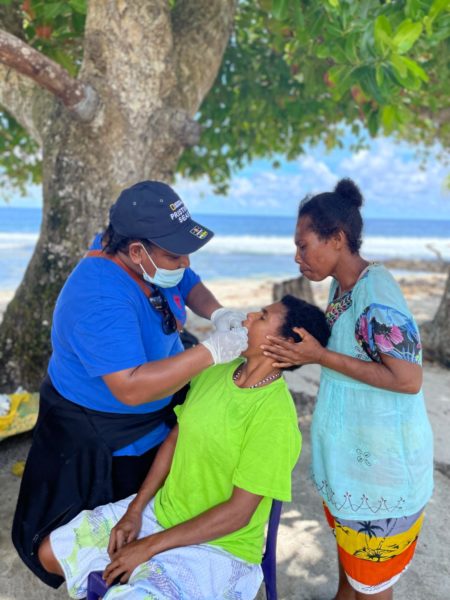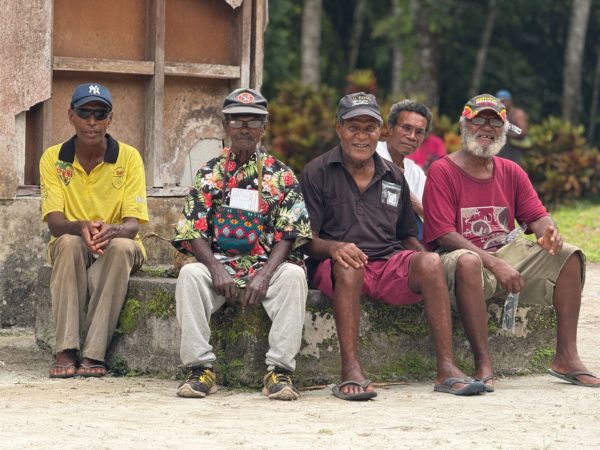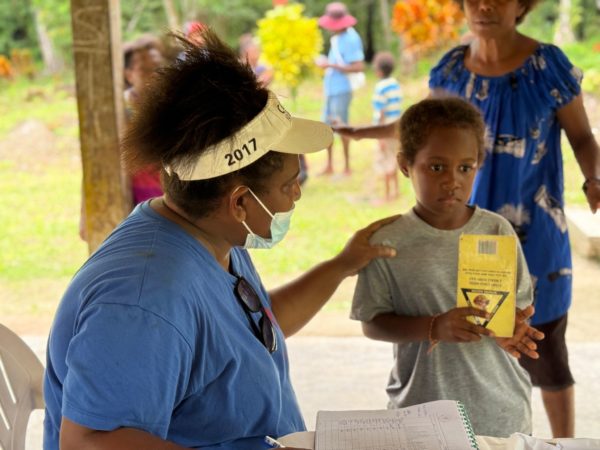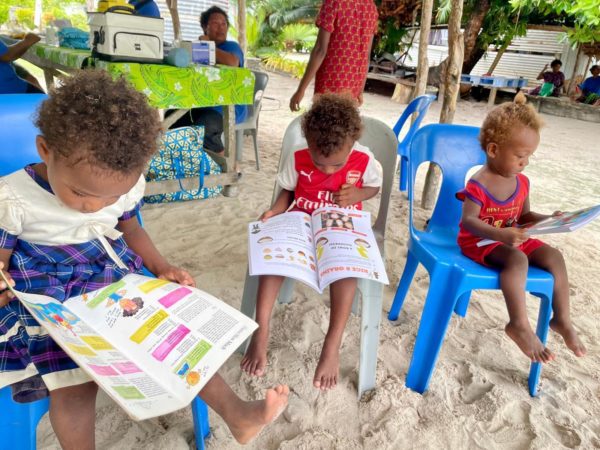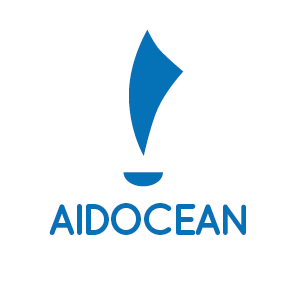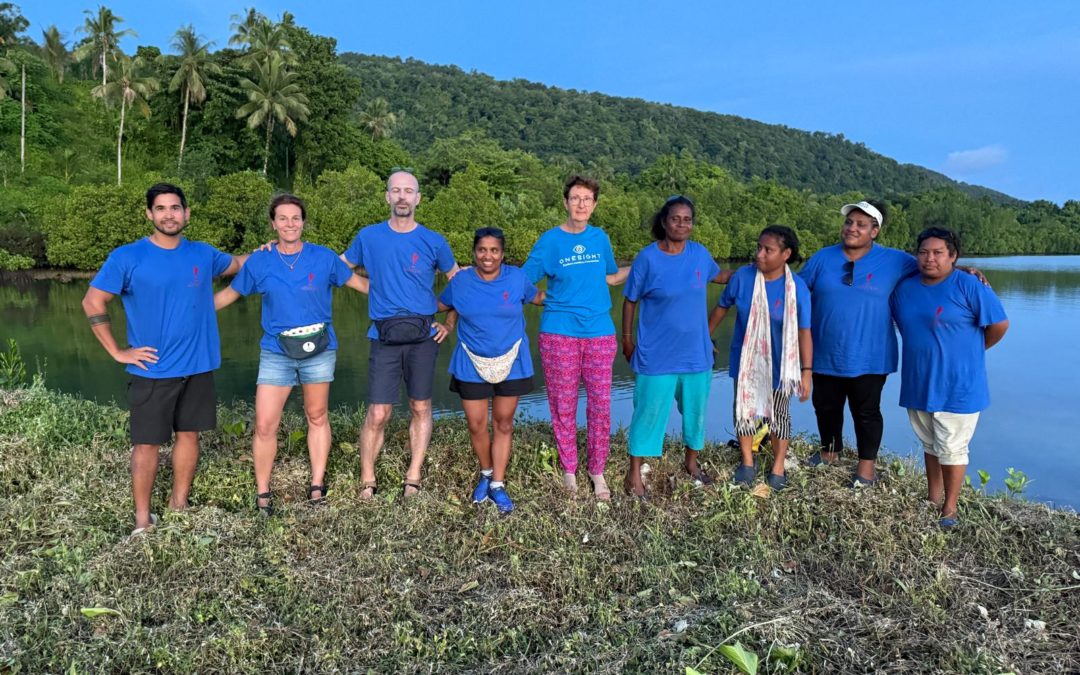A new mission and a new destination: the northernmost islands of Papaouasie New Guinea, where Aidocean will be providing medical care this spring. Christophe, the team doctor, takes you through the daily life of this PNG 2025 mission.
Day 1, Monday 07/04/2025
After two days’ travel, we join Marine, who has already been stationed in Papua for a week. A week of knocking on the doors of sponsors and authorities to make progress on this new mission, and already planning the next ones. The list is long, but not exhaustive. French Embassy, Papuan Health Authority, WHO, UNICEF, bank. Aidocean has become a Papuan in its own right.
Two days that took us from Nouméa to Kavieng via POM. Three of us joined her: Françoise, our gynecologist, now a regular on her third mission, Dorothée, a midwife, and myself. This year, the team has been reduced to four nurses and Bambou, the technical developer from Biomi, who is accompanying us. With the help of a revolutionary universal immunology strip reader, he will be able to screen for tuberculosis and malaria… and that’s only the beginning.
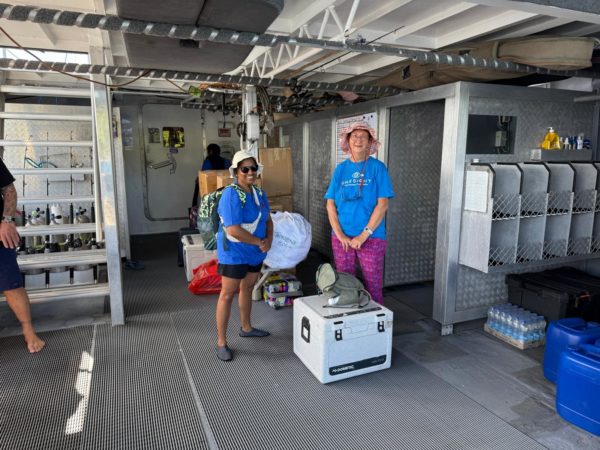
After the plane, the boat, a night’s sailing and here we are aboard the PNG Explorer for a night at sea. We’re due to arrive the next morning to get the day’s work off to a flying start. We’re not here for a honeymoon.
Day 2, Tuesday 08/04/2025
The morning gets off to a gentle start, and the day ends at nightfall.
The Dinghy (a small speedboat) drops us off at the coast. A presentation to the local authorities, an update on the mission schedule, and off we go in the bed of a pickup truck with slick tires on a dirt road that takes the pothole as its standard.
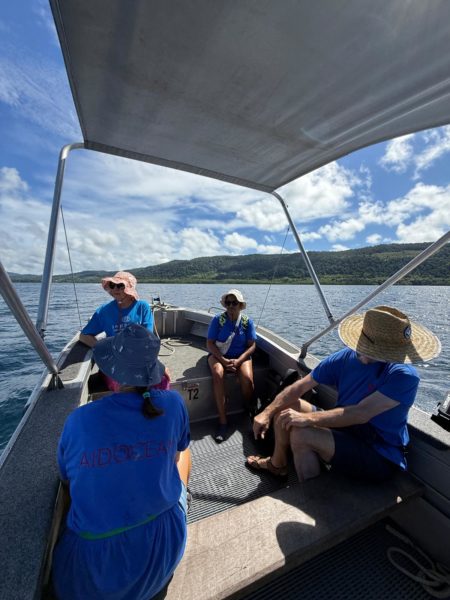
They told us 30 minutes. We believed them! The other end of the island is a good hour away!
A seaside village, a postcard facing the Bismark Sea. The consultation room fills up slowly but surely. Consultations follow one another without urgency, as they did last year, with health records piling up one on top of the other.
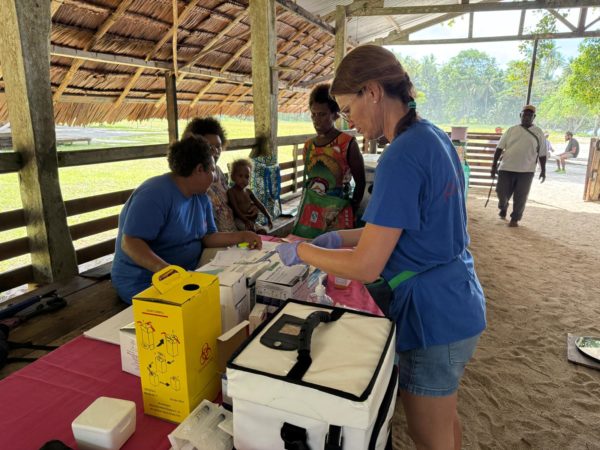
People are older and have osteoarthritis, but few acute pathologies. A little diabetes, which is new compared to last year. Thanks to Bambou, we tested for malaria and tuberculosis, and not a single one was positive. Almost unbelievable! The village suffers from a lack of fresh water for 5 months of the year. The only reserves are provided by rainwater tanks, but there are no wells, and the real springs are far away.
As the afternoon draws to a close, night catches up with us on the way back by dinghy to our floating base camp.
Day 3, Wednesday 09/04/2025. Palakau and Loitae
First real working day, starting early in the morning. 3 villages at a crescendo, Palakau and Loitae. The first has a dispensary that would not be outdone by New Caledonia’s Island Province. A delivery room with a manually-tilting table, hospital beds, refrigerator on solar panels… Because electricity is dependent on a generator, which in turn is dependent on available fuel. And even with a reserve for emergencies, that doesn’t leave much time for daily light. Unfortunately, we leave quickly, as there are few patients, and after a 15-minute banana boat ride, we find ourselves in a classroom emptied of its occupants for the occasion.
for the occasion. A little more work for the vaccination, and still the lot of elderly people with chronic pathologies waiting for a miracle or a tablet, often with a disappointed look on their faces at the end. A little further on, we’re at the logging company’s base camp. Some vaccines, some old people, some malaria…
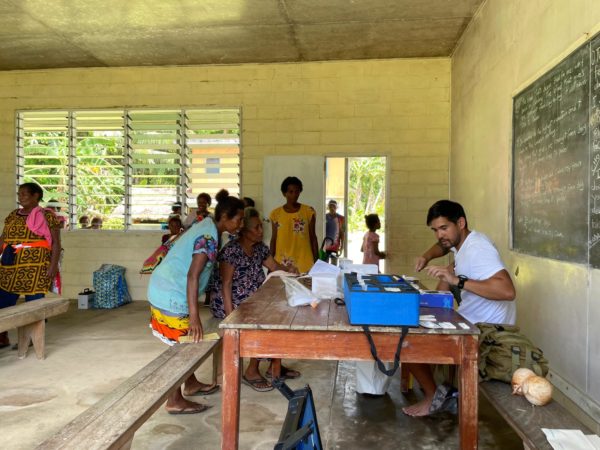
After two days, the team members were unanimous in their assessment. Half of the patients are elderly, well-dressed and clean, while the rest of the population consists of 2 children who have already been vaccinated and one woman who has already received an implant. No skin diseases, no tuberculosis or leprosy. At most, a few cases of malaria.
We’re beginning to wonder whether we couldn’t be more useful elsewhere. And yet, who would have thought that this large island, 12 hours by sea from New Ireland, would have been so well provided for?
Day 4, Thursday 10/04/2025. Lomaku Nauru and Naroi.
We’ll have to look the raison for it in Jennifer, who concocted the program around her schedule for the fight against HPV. This is her island, and she wanted to tour the HPV infections there before implementing the treatments.
And as for the population’s relative good health, perhaps the money brought in by the timber company is more to the point.
The day is spent in the village hall of Lomakunauru, huge and dark. 4 vaccinations, 7 children seen and no implants. General consultations continue to account for the vast majority of visits, while Bambou keeps busy with his mini-lab and, of course, the dentist, who pulled 17 teeth today.
At the end of the day’s briefing, we decide to ask for a change of program: to return to New Hanover, where we were 2 years ago and where the needs were great. We will therefore ask the director of the Kavieng hospital to approve this new itinerary.
Day 5, Friday 11/04/2025, Eloaua, Mananusa
Today, two islands to visit in a small lagoon with turquoise waters. Before this escapade, an emergency to visit on the main island.
Urgency becomes relative when the patient greets us with a smile. Françoise, our gynecologist, will stay on for the day to see how HPV screening and treatment is going.
On the island of Eloaua, the Aidocean team is already on duty and fully staffed for a few vaccinations. Despite the island’s isolation, the children and women are still well cared for overall.
On the second island, larger in size but smaller in population with around 100 people, the consultation room is open to the 4 winds, with a roof and 4 planks, and an unobstructed view over the lagoon, without doubt our most beautiful room. Intimacy guaranteed!
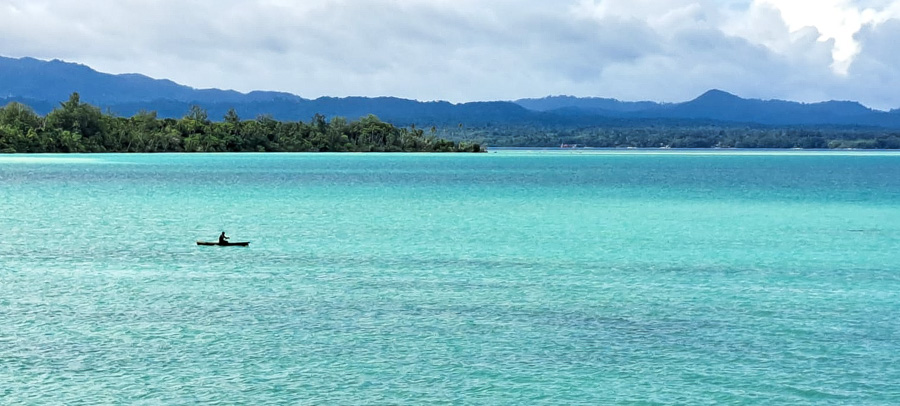
We also visit 2 disabled children with chronic neurological diseases. Care for the second is very basic. He lies on a tarpaulin, protected by a mosquito net, in a small house on stilts, awaiting the return of his grandmother who looks after him. He looks at us with a blissful smile.
Back at the boat, Marine calls the CEO of the Kavieng hospital, Dr Steinard, to get an answer about the change of program for the rest of the mission. He’s not in favor, as the fight against HPV is a priority for him. So we’ll be sticking with the pre-determined HPV-focused program. We’re going to optimize patient care. The mission is far from over.
Tomorrow will be a day for reflection, tomorrow is Sabbath day for 7th Day Adventists.
Day 8 : Monday 14/04/2025, Tasitel
After a day’s rest, we’re back on the road. The program wasn’t always the one we’d understood the day before, but that didn’t matter – the main thing was to be there. In the end, it was the inhabitants of 4 villages who came to consult in the same place.
A dispensary undergoing renovation, occupied by a retired nurse who still works part-time in this village and part-time in another. The few shelves are filled with out-of-date products and construction tools. The renovated sections already look worn in places.
Vaccinations are given on the beach, with the ocean humming its waves over the few meters of coral that separate us from the open sea.
Marine starts handing out glasses, and people are happy to be able to read again, or just happy to have sunglasses on their noses.
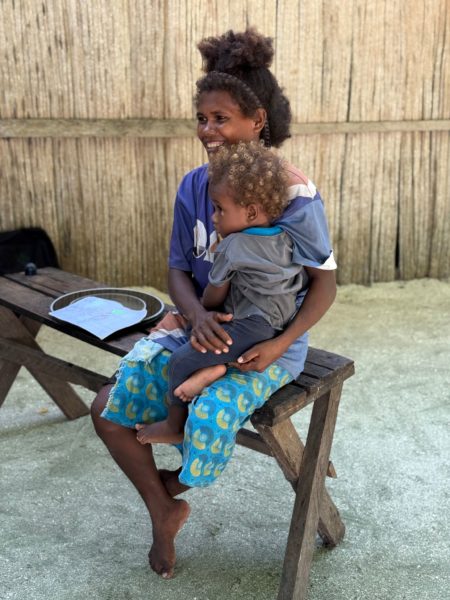
Day 9 : Tuesday 15/04/2025, Mussau, Boliu, Noanaulu and a desert island
It’s the day of the 4 islands, a day that ends with a dive in a coral garden dotted with clams with multicolored lips. So much for the postcard. When it starts like that, the other side of the story could prove difficult. Not this time. It’s just like what we’ve encountered so far. Boliu is the most densely populated, with a few huts on stilts lining the beach with their eyes in the turquoise. Consultations take place with your feet in the sand on the back of an upturned canoe. We found a little bit of malaria and the more exotic return of a skin pathology we hadn’t come across before: Tinea Imbricata. A mycosis in the ringworm family, but more likely to be found in remote areas. Our busy family planning duo set up shop in the boarded-up church for a few implants and vaccines at the door. For a few hours, the hamlet was transformed into an improvised dispensary.
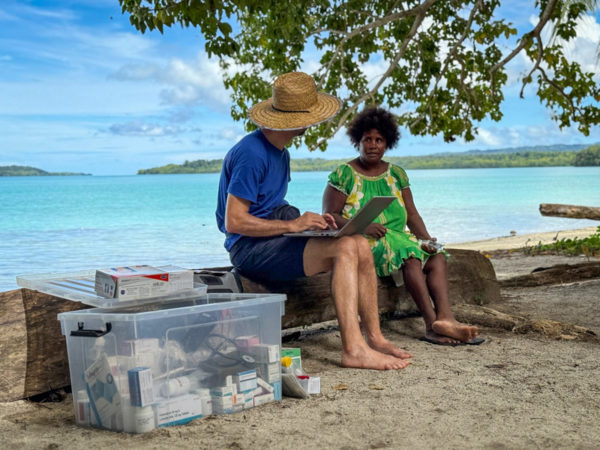
To get to the island opposite, we cross the lagoon and pass the bulk carrier that has been anchored in the bay for several days. We approach this steel giant adorned with 4 cranes soaring above the green and blue backdrop, a two-tone palette at the end of the universe. In its lair lies a reclining forest, tied between metal stakes. Huge, bare logs fly from a barge and pile up, numbered. The Papuan forest is one of the resources often exploited by foreign companies…
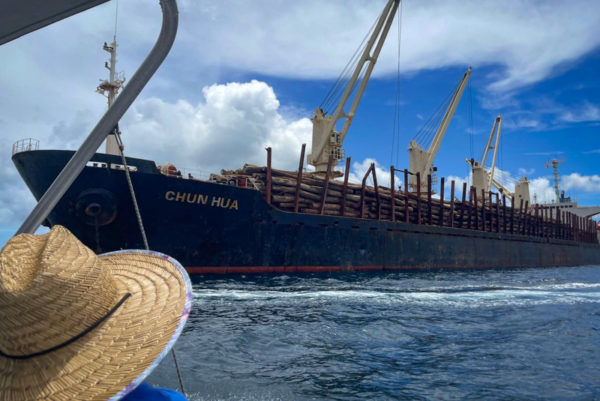
Day 10, Wednesday 16/04/2025,
Our plan was to take a banana boat to a village on the coast halfway to what we considered the tip of the island. We made our way, bumpy in a 4×4, towards the aforementioned end. The unexpected always happens, and this morning Marine had a good nose for it when she arrived at the jetty. There was no boat to pick us up, so we boarded the PNG Explorer and set off again. “We’ll take some fuel in case the ambulance runs dry.” The ambulance was perfectly dry! An hour’s drive later, we disembark in a small village, seaside, lagoon… a real desert. We get out of the vehicles, cautious. “Ah, Aidocean, we’re expecting you, but tomorrow. Moral of the story: all the inhabitants are in the fields or at work, in short, absent. It’s the village at the far end that’s waiting for you today. And indeed, the village is there waiting for us, massed in front of the school.
We didn’t come for nothing, that’s the main thing. The village chief thanks us warmly for our presence and the care we’ve provided. Vaccination records will soon be approaching figures worthy of industrialized countries.
Tomorrow, we know where we’re going…
Day 11 , Thursday 17/04/2025
Papuan time is neither here nor there. We think we know and we don’t. Moreover, time here is a strange notion that can only be grasped with… time. The philosophical dimension this provokes often leaves us wondering, dreaming or grumbling. The latter never being the
never the right one.
Why try to master something so vast? At least one culture separates us, and it’s already a miracle that a patient can give us his age with relative precision. With a hesitant look, he searches, eyes in the dark, then gives up. The question that comes back and nags him starts the machine again in the void of an impossible count. Finally, he smiles and indicates a date in the form of a question mark. Work out the math.
I’m sure you’ve gathered from yesterday that… we thought we knew, but we had no idea what we didn’t know.
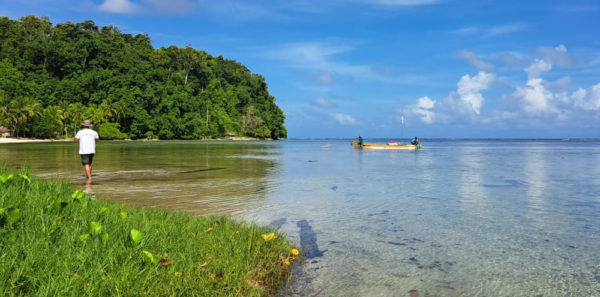
But what happened on the morning of April 18? Precisely, nothing! We waited in vain for the car which, as agreed the day before, was to pick us up and take us to the village where we had stopped the day before. So we returned to the loggers’ base camp to find some activity. And it wasn’t all in vain. Three paludisms out of a dozen or so tests, and a few reading glasses for avid readers of Spanish romances on the last light of a dying electric lamp battery (or simply anyone who wants to slip the thread through the needle’s cat to mend a net).
Marine did, however, go to tomorrow’s village, which is today’s village, where we went yesterday to proclaim that we’ll be coming… tomorrow by boat. And there too, it was not a lost cause. The village and those next door were still awaiting our arrival at 4pm. I promise, we’ll come tomorrow.
Day 12, Friday 18/04/2025, Tanaliu
An hour by banana boat in the open sea to get to the aforementioned village. The village’s anticipation of our arrival didn’t dampen the welcome we received. A welcome speech and a bouquet of flowers placed prominently on the table, followed by a blessing from the pastor. This is the first village with a clear stream nearby, guaranteed crocodile-free (or almost) by the local residents.
The problem stream is further away, the girl tells us with a vague wave of her hand. Children are playing at throwing themselves from the branches of trees that hang a few meters above the water.
Tonight we bid farewell to the island of Mussau. When we wake up tomorrow morning, we’ll already have weighed anchor for the island of Emirau… well, for those of us who sleep in the swell at the anchorage. Seasickness is nailing some of us to our bunks this evening.
Day 13 : Saturday 19/04/2025
Saturday is church day. We set sail early in the morning, bound for the island of Emirau. Five hours of peaceful sailing, cradled in our bunks by a gentle swell. The anchorage is just the right size for the boat, between two coral islands, the water is crystal-clear, and at the end of the channel there’s a wave that we’ll be surfing later on, weather permitting. We’ll be greeted by a hundred dolphins who’ve come to surf with us. So far, the day of rest seems to be unfolding indolently: “And for lack of a breeze, time stands still… moaning is out of place…”.
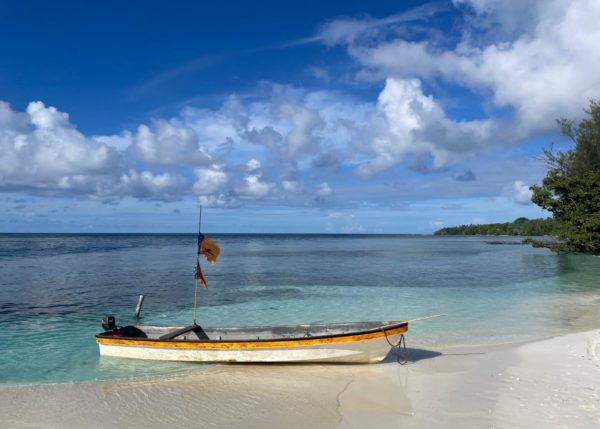
But before the waves, the staff in charge of setting up for the next few days meet in the saloon, to get things straight about programs and vaccinations.
In the early afternoon, we go ashore to visit the dispensary and give the “talksaway”, i.e. to announce our arrival the following day. As we set foot on the beach, we learn that a young man is very ill, and it would be good to visit him quickly. We walk a hundred meters along the seafront road until we come to a crowd of people standing around a man covered in sweat, supported by two grandmothers, with both feet in a bucket of hot water.
And indeed, seen from this angle, he’s not in the best of shape. Stomach ache, vomiting, fever, slight cough. We decide to head back to the boat to stock up on a minimum of medical equipment.
On our return, the village has moved the patient close to the area where we are mooring the dinghy, on a mat.
Seven malaria tests later, all positive and as many treatments distributed, we understand what “malaria outbreak” means. Tomorrow looks promising.
We don’t go to the dispensary, it’s far away: four kilometers in the late afternoon with an outbreak of malaria, both falciparum and other plasmodium, doesn’t seem reasonable. Brave but not foolhardy! In any case, the truck has no diesel.
Day 14 : Sunday 20/04/2025 Emirau 1. Loao
From a medical point of view, the malaria epidemic wasn’t so bad after all, and that’s all to the good. One abscess drained, 6 malaria cases of all types and, for the first time, a positive tuberculin test. We take the opportunity to test the family present. This was an elderly, emaciated person with a suspicious, i.e. very pronounced, scoliosis (spinal deformity). This suspicion was established on the basis of the rapid screening tests supplied by the Prism company and the expert hand of Bambou, our Biomi technician (the name of the machine used to read the tests). Apart from this “surprise”, which will have to be confirmed by further tests on Kavieng, we carried out our daily batch of consultations, distributed our batch of glasses to the population thanks to a donation from the Onesight Essilor Luxottica Foundation, pulled around 15 teeth and vaccinated up to 10 children who were behind schedule. Jennifer, for her part, kept the PCR testing machine for HPV (which causes cervical cancer) running at full speed.
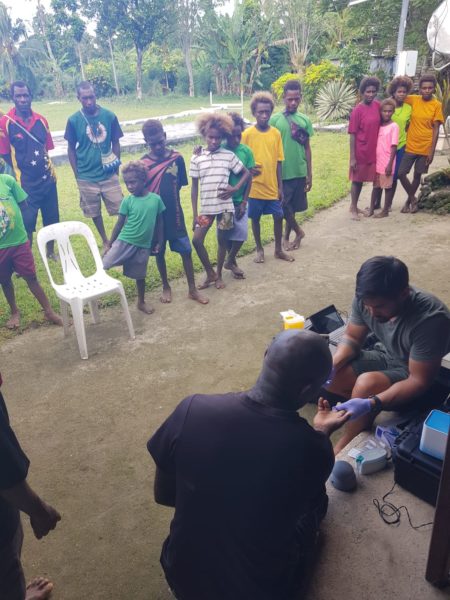
Day 15 : Monday 21/04/2025 Emirau 2.
After a few consultations in the heat of the day, and a few malaria cases later, we embark on a tour of the island. Emirau has a very special history.
During the Second World War, the island was home to an 18,000-strong American training base. For a 4km x 7km piece of flat land lost in the middle of the ocean, it must have quickly become overcrowded. Two concrete runways, each 2.5km long (a mixture of cement and crushed coral), roads, buildings… We walk back and forth along the flight paths, one reserved for bombers, the other for fighters. Enola Gay (the bomber that dropped the atomic bomb on Hiroshima) was, according to our guide, stationed here.
All that remains is the cement of the runways and the sparse vegetation that grows back painfully between the crevices. One of them was still in use until 2022. What’s striking about this island is the size of its inhabitants and children. The adults tell us that nothing grows here, only coconut palms. They find it extremely difficult to grow the staple foods (Tarot, Manioc) or simply bananas, which are the staple diet of these populations.
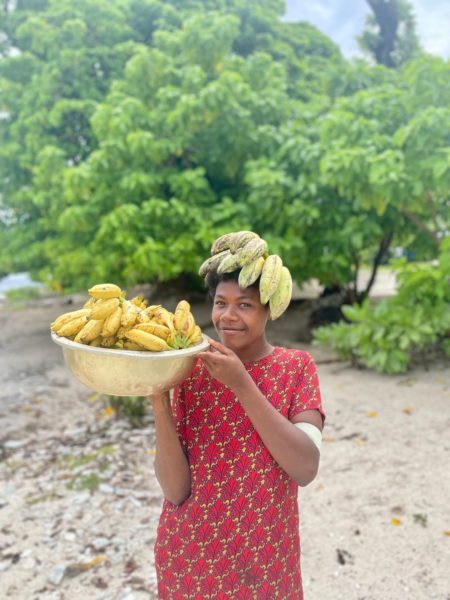
Agroforestry could perhaps help them improve the problem, as slash-and-burn farming is still the local standard, which from a vegetation point of view is not the best way. It’s a safe bet that the concreting of the island is partly responsible for this situation. As with all the surrounding islands, there is also a chronic lack of water during the dry season, which lasts 4 to 5 months of the year. Watercourses are rare and quickly dry up on these isolated lands.
Day 16 : Tuesday 22/04/2025 Emirau3.
A rainy day. It hadn’t happened since the beginning of the mission. Here it is today.
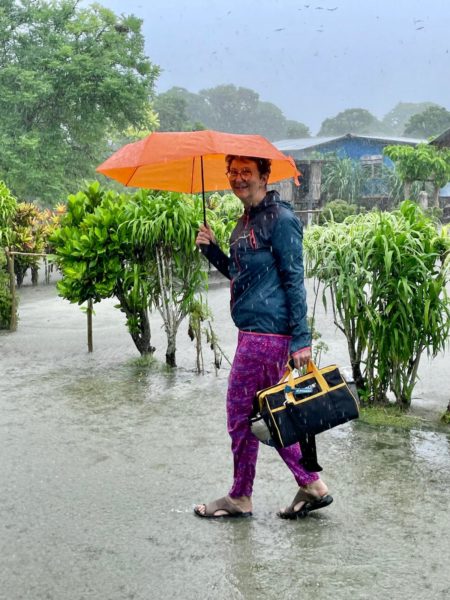
A little indolence set in on board for a few early hours, when visibility was limited to a few meters. The boat isolates itself in a sound and damp cocoon. We wait for the tropical deluge to stop. And soon it did. The island’s bumpy paths and concrete roads finally open their arms to us as we head for a final village in the north. As usual, the flowers are on the table, planted in pots made of green papaya.
The rain has given way to a greyish sky and the humid heat rising from the vegetation. Consultations come and go at a slow pace. And always a few malaria cases slyly pointing us north. Its clinical presentations are numerous. If you’ve had intermittent fever for a few years, you may have malaria. If your spleen hurts, you may have malaria. It’s everywhere, and many cases are duplicates of falciparum and one of the others more adapted to humans (ovale or malariae). Malaria of the falciparum type is unfortunately reputed to be responsible for the most severe forms of malaria.
We spend the night at sea, heading for what the jealous inhabitants of Emirau call “Banana Island”. A conversation with Evelyne the dentist in the evening in the boat’s narrow saloon tells me that this island has been almost entirely concreted over, and that cement abounds everywhere under the vegetation. Offshore, there’s equipment sunk by the Americans before they left, and on the island there are burial pits.
Two children were seriously injured by bombs last year. War never really ends in casualties. We tend to forget that.
Day 17 : wednesday 23/04/2025. Tens
Bird Island. An island in the middle of nowhere, a piece of vegetated coral lost in the ocean. No land in sight. Robinson Crusoe is among us. What are these people doing living on a fixed boat no more than a kilometer long? Not even an aircraft carrier. Fifteen minutes to go around it…or so we were told. This was without taking into account the Papuan notion of time, a rubber band with perpetual motion and numbers that mean nothing.
“- How many of you are on this island?
– 15 plus.”
That doesn’t answer my question, yes, but it’s his answer…
Neither do the birds, you can’t count them, hundreds, no, thousands. Black and white boobies, frigate birds and shearwaters. Reminiscent of New Caledonia. There are also a myriad of other species that we don’t know about, nesting above the houses with a strong sonic and olfactory presence. The island is therefore fertile. We take an accompanied tour, which isn’t supposed to last very long… A lesson in Papuan survival. The tour begins with a freshwater well. Two meters of water in a drainage area in the middle of the island that fills up even in the dry season. The old man serving as our guide boasts: “You see Emirau and Mussau, in the dry season they have no water and they’re hungry, that never happens here.”
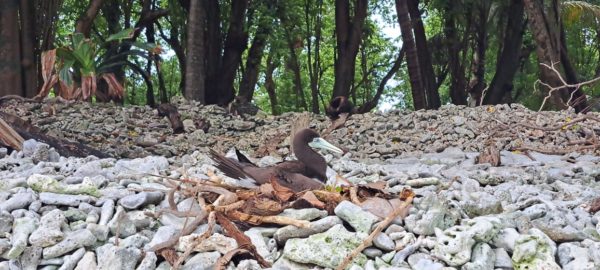
Copra (the dried flesh of the coconut) disappeared with the death of the coconut palms from beetle infestation. It has given way to a luxuriance of banana and tarot trees. There are cats here to balance out the rats that are prevented from climbing the trees to preserve the nuts. The few coconut crabs eat something else, as they have to survive… nobody eats them anyway…
A big tide in 2018 gnawed away at the windward side of the island and created a metre-high wall of coral. There are boobies nesting on the ground and incubating their eggs. They watch us warily as we pass. The dog accompanying us doesn’t even mind, it’s like an animal peace. We take a shortcut to the village, passing Will Smith’s pirogue, where he filmed two years ago. The relics of Hollywood propaganda come to even the most remote parts of the world… Hardly believable! The rain falls on the tin courtyard like a clumsy drummer on a drumhead. Our words are scarce in the din.
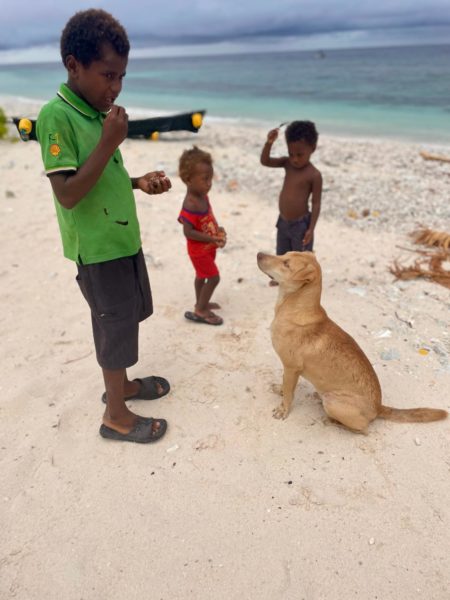
Let’s talk medicine. A little malaria in the mosquito hatching, a few scattered fevers. Fourteen tests, twenty-two people living here. Not a single positive. Evelyne and her assistant did pull 4 teeth and our gynecologists put in two implants. We also distribute a few books supplied by the Buk Bilong Pikinini association to the island’s children. They are delighted to have access to school supplies. There hasn’t been a teacher in the area for 2 years…
We leave, and it’s important to stress this, with several dozen kilos of bananas, which delights everyone.




